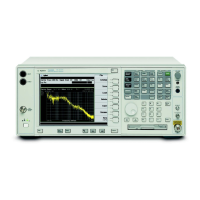56 Chapter 2
Overall Troubleshooting
Isolating the faulty assembly when the displayed amplitude is incorrect or the instrument fails
a gain related Auto Align test
Instruments without Basic Mode (Option B7J or Option 122 or 140)
a. Press the green
Preset key.
b. Press
Mode, Spectrum Analysis.
c. Turn on the internal 50 MHz calibrator or inject a 50 MHz,
−25 dBm signal into the PSA RF input. Tune the PSA to 50 MHz.
The PSA block diagram shows expected power levels at the inputs
and outputs of the assembly blocks. Follow the instrument set-up
instructions in the upper right hand corner of the block diagram.
d. To check the signal path from the A14 Input Attenuator to the 2
nd
IF Amp on the A10 3
rd
Converter, connect a spectrum analyzer to
the 321.4 MHz IF Out on the PSA rear panel and measure the
321.4 MHz output signal. The signal level should be about
−30 dBm.
If the signal level is correct:
The signal path between the RF input connector and the 2
nd
IF
Amp on the A10 3
rd
Converter is good.
The PSA block diagram shows expected power levels at the
inputs and outputs of the assembly blocks. Follow the
instrument set-up instructions in the upper right hand corner
of the block diagram.
Measure the input signals and output signals of each circuit
assembly between the input to the 3
rd
Converter and test point
TP5 on the A7 Digital IF.
If the signal level is not correct
There is a problem with the signal path between the RF input
connector and the 2
nd
IF Amp on the A10 3
rd
Converter.
Measure the input signals and output signals of each circuit
assembly between the input connector and 3
rd
Converter until
you find the wrong signal level. When checking the input
attenuators, cycle through the attenuator steps to assure all
attenuator steps are correct.

